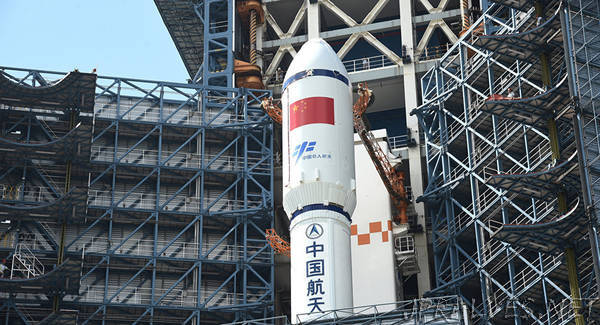
“China’s Long March 8, one of the country’s future launchers, could have a reusable first stage, according to a statement made recently by a Chinese rocket designer. While not a lot of information has been disclosed so far by Beijing regarding its future boosters, Western experts expected that the new design would be an expendable rocket.
The initial project called for a two-stage launch vehicle with an additional two or four solid rocket boosters. In such a configuration, the Long March 8 could be capable of lifting up to 4.5 metric tons into a Sun-synchronous orbit. However, more ambitious plans for this rocket were presented by Long Lehao, chief designer of carrier rockets at the China Academy of Launch Vehicle Technology (CALT), during an April 24, 2018, space conference in Harbin, China.
According the state-run Xinhua press agency, Lehao said the first stage and boosters of the Long March 8 are expected to be retrieved through vertical landing, adding that if the project succeeds, the new partly-reusable rocket would provide commercial launch services to customers around the globe.
“China’s aerospace industry is making efforts to develop low-cost vehicles that can enter space rapidly to support future large-scale space exploration and promote a commercial space industry,” Lehao was quoted by the state-run Xinhua press agency as saying.
Rocket reusability is also important to China for safety reasons, Lehao said. The country conducts around 20 orbital launches annually and this year could be record-breaking as about 35 mission are in its launch manifest. The most recent flight occurred May 3, 2018, when the country’s Long March 3B launched the APStar-6C communications satellite.
Given that almost every Chinese rocket flies over mainland China, residents in possible drop zones of rocket stages have to be evacuated at every launch. This is also necessary because sometimes rockets fail. For example, in August 2016, a Long March 4C failed to reach orbit, and its pieces landed near villages several hundred miles downrange.
“As the current Long March 2, 3, 4 series rockets are fueled by toxic propellants, they cannot be recycled. But we are developing technologies to precisely control the fall of the rocket remains to ensure safety,” Lehao said.
Another Chinese rocket scientist speaking at the conference, Bao Weimin, who is the director of the Science and Technology Commission of the China Aerospace Science and Technology Corporation, said that China will use reusable technology different from that employed by SpaceX for its Falcon 9 booster. What technology that would be, however, was not disclosed.
The first launch of the Long March 8 rocket is currently targeted for around 2021. According to Xinhua, the reusability of the first stage of this booster is the first step of China’s long-term goal to launch fully-reusable rockets on regular basis by 2035. Another important milestone toward achieving this goal would be the development of a reusable suborbital spacecraft by around 2025 and a rocket with two reusable stages by 2030.
This isn’t the first time an organization in China has proposed a reusable rocket. In September 2017, it was reported that a Chinese startup company called Link Space was developing a two-stage rocket called Xin Gan Xian 1 (or New Line 1). The rocket would be much smaller than a Falcon 9 and would lift around 440 pounds (200 kilograms) into a Sun-synchronous orbit, but the first stage would employ hardware similar to those used on SpaceX’s rockets, such as landing legs and grid fins.”
